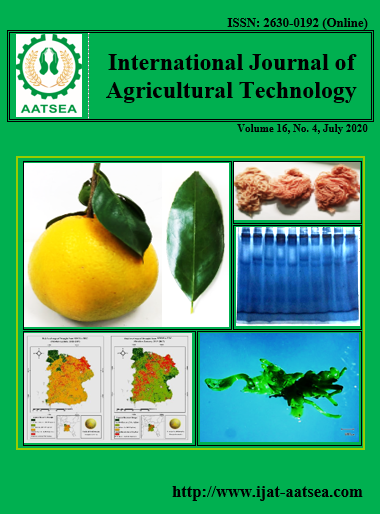Factors affecting the adaptation of farmers affected by the urban expansion of Chiang Mai city
Main Article Content
Abstract
It has been many affected factors in urban expansion on the agricultural sector in Chiang Mai, Thailand. The research revealed that urban expansion caused to decrease in agricultural areas, while housing projects, shopping malls, buildings, and numbers of non-local labors were increased. Farmers noticed these changes in low-level of adaptation. The five factors found significantly affected the farmers’ adaptation. The farmers who gained high education, small agricultural land, in membership group, and received agricultural information from various sources, and agreed that there are changed in agriculture due to urban expansion found to be high level of adaption. Government officers should raise the farmers’ awareness of urban expansion that affected on the sustainability of agricultural occupation. They should promote adaptation knowledge and provide production inputs to the farmers. Furthermore, farmer group should be encouraged the farmers to share their knowledge and experiences with others.
Article Details

This work is licensed under a Creative Commons Attribution-NonCommercial-NoDerivatives 4.0 International License.
References
Bennett and John, W. (1969). The Northern Plainsmen: Adaptive strategy and agrarian life. Chicago: Aldine.
Chiang Mai Provincial Agricultural Extension Office (2001). Agricultural information of Chiang Mai production year 2000/01. [in Thai].
Chiang Mai Provincial Agricultural Extension Office (2018). Agricultural information of Chiang Mai production year 2016/17. [in Thai].
Creswell, J. W. (2012). Educational research: planning, conducting and evaluating quantitative and qualitative research. Pearson Education, Inc. Boston, pp. 539-544.
Grothmann, T. and Patt, A. (2003). Adaptive capacity and human cognition. In: Meeting of the Global Environmental Change Research Community, Montreal, Canada, pp. 1-19.
Heimlich, E. R. and Barnard, H. C. (1992). Agricultural adaptation to urbanization: Farm types in northeast metropolitan areas. Northeastern Journal of Agricultural and Resource Economics. Northeastern Agricultural and Resource Economics Association, 21:1-11.
Inwood, M. S. and Sharp, S. J. (2012). Farm persistence and adaptation at the rural-urban interface: Succession and farm adjustment. Journal of Rural Studies, 28:107-117.
Jongkroy, P. and Thongbai, C. (2014). Patterns of the Spatial Distribution of Urbanized Areas in Thailand. Kasetsart Journal of Social Sciences, 35:30-44.
Kamal, N., Imran, M. and Tripati, K. N. (2016). Greening the Urban Environment Using Geospatial Techniques, A Case Study of Bangkok, Thailand. International Conference - Green Urbanism. GU. Published by Elsevier.
Kontothanasis, G. (2017). Social practices of urban agriculture in the metropolitan region of Thessaloniki. Procedia Environmental Sciences, 38:666-673.
Larson, J. M., Findeis, J. L. and Smith, S. M. (2001). Agricultural Adaptation to Urbanization in South-eastern Pennsylvania. Agricultural and Resource Economics Review, 30:32-43.
Marion, R. Alban, Th. and Jacques, E. B. (2016). Processes of adaptation in farm decision-making models. A review. Review article. Agronomy for Sustainable Development, 36:64. DOI 10.1007/s13593-016-0402-x.
Moench, M. and Dixit, A. (2004). Adaptive Capacity and Livelihoods Resilience. The Institute for Social and Environmental Transition. International, Boulder, Colorado, U.S.A. and the Institute for Social and Environmental Transition, Nepal.
Naab, F. Z. Dinye, R. D. and Kasanga, R. K. (2013). Urbanization and its impact on agricultural lands in growing cities in developing countries: A case study of Tamale in Ghana. Modern Social Science Journal, 2:256-287.
National Statistic Office Thailand (2017). Chiang Mai’s Provincial Statistic Report: Population and Housing Census. Chiang Mai Statistic Office. Chiang Mai Government Center. (in Thai).
Nirathron, N. and Piemyat, S. (2010). Adaptive Strategies of Farmers Affected by Free Trade Agreement. Human Resources Institute, Thammasat University. National Research Council of Thailand.
Omondi, S. O. Kosura, W. O. and Jirström, M. (2017). The role of urban-based agriculture on food security: Kenyan case studies. Geographical Research, 55:231-241.
Pham, V. C., Pham, T.-T.-H., Tong, T. H. A., Nguyen, T. T. H. and Pham, N. H. (2014). The conversion of agricultural land in the peri-urban areas of Hanoi (Vietnam): patterns in space and time. Journal of Land Use Science DOI: 10.1080/1747423X.2014.884643.
Redwood, M. (2009). Agriculture in Urban Planning: Generating Livelihoods and Food Security. International Development Research Centre. London.
Sasima, F., Suneeporn, S. and Panya, M. (2016). Farmer’s Perceptions towards Economic Sustainability of Rice Farming in Peri-Urban Area, Bangkok, Thailand. International Journal of Agricultural Technology, 12:1759-1772.
Satterthwaite, D., McGranahan, G. and Tacoli, C. (2010). Urbanization and its implications for food and farming. Philosophical transactions of the royal society B, 365:2809-2820.
Suteethorn, K. (2012). The Impacts of Food miles on The Pattern of Footprint of Bangkok’s Food supply. NAJUA: Architecture, Design and Built Environment, 26:71-93.
Tripathi, S. and Rani, C. (2018). The impact of agricultural activities on urbanization: Evidence and implications for India. Journal International Journal of Urban Sciences, 22:123-144.
Tsubota, K. (2007). Urban Agriculture in Asia: Lessons from Japanese Experience. FFTC Annual Report 2006.
Tsuchiyaa, K., Harab, Y. and Thaitakooca, D. (2015). Linking food and land systems for sustainable peri-urban agriculturein Bangkok Metropolitan Region. Landscape and Urban Planning, 143:192-204.
Uddin, M. N., Bokelmann, W. and Entsminger, J. S. (2014). Factors Affecting Farmers’ Adaptation Strategies to Environmental Degradation and Climate Change Effects: A Farm Level Study in Bangladesh. Climate, 2:223-241.
Yamane, T. (1973). Statistics: An Introductory Analysis. Third edition. Harper and Row Publication, New York.


